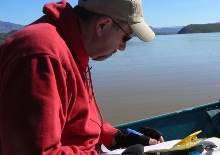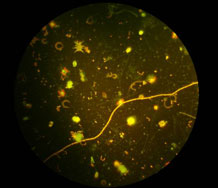
Algal blooms in the Salt River Reservoirs
The Salt River reservoirs are a major water supply system for the Phoenix Metro area. In addition to water storage and hydropower, the lakes also have a great recreational value, including boating and fishing. In recent years (2003 onwards) however, fish mortality has been a recurrent problem in the Salt River Lakes. Recurrent blooms of algae known to release toxins, such as the chrysophyte Prymnesium parvum (Golden Alga), as well as cyanobacteria (Anabaena, Anabaenopsis, and Cylindrospermopsis) have been linked to these fish kills. In a project funded by the NSF Water Quality Center at ASU, the Neuer lab has started to investigate the succession of plankton populations in the Salt River Reservoirs, specifically Saguaro and Roosevelt Lake, with the goal to develop an early warning system of noxious algal blooms using satellite remote sensing.
To the right are microscope images of plankton (from top to bottom):
Epifluoresence microscopy image of a plankton assemblage (cells are illuminated by their pigment autofluorescence after blue light excitation) collected in March 2007 from the surface water of Saguaro Lake and filtered onto a 0.2 µm pore size membrane filter. The string of cells is a filamentous cyanobacterium.
Epifluoresence microscopy image of a diatom from the genus Asterionella.
Light microscopy image of colonial green algae from the genus Scenedesmus.
Epifluoresence microscopy image of a filamentous cyanobacteria from the genus Anabaena
SOLS magazine containing background article
References:
Tarrant P. and S. Neuer. 2009. Monitoring Algal Blooms in a Southwestern U.S. Reservoir System. EOS Transactions. 90(5) 38-39.








